ASUS Maximus V Gene vs. Gigabyte G1.Sniper M3 Review
by Ian Cutress on May 13, 2013 10:00 AM EST- Posted in
- Motherboards
- Gigabyte
- Asus
- MicroATX
- Z77
_678x452.jpg)
Competition between gaming mATX boards doesn’t get any tougher than this. In the red corner, weighing in at $200 and from the Republic of Gamers’ range, we have the ASUS Maximus V Gene. In the green corner, weighing in at $170 and providing the competition, we have the Gigabyte G1.Sniper M3. Let’s get ready to review!
ASUS Maximus V Gene Overview
The ASUS MVG has a good heritage behind it – the Republic Of Gamers brand is now a definitive landmark in the motherboard arena, where from the least expensive to the extreme board we have consistency in terms of BIOS, software, optimizations and effort on behalf of the manufacturer. In our testing it is clear to see why – the MVG performs very well across the board.
For the price of $200, we get a gaming motherboard with overclocking potential. On board are the characteristic features of the ASUS ROG range – aside from the red and black livery, we get a mPCIe combo card for a WiFi card and half-height mSATA card, an Intel NIC, voltage read points, five fan headers, additional SATA 6 Gbps, additional USB 3.0, onboard power/reset buttons, and SupremeFX audio (an enhanced layout for the Realtek ALC898 codec). In the software are the best fan controls ever placed on a motherboard with FanXpert II, alongside USB 3.0 Boost, ROG Connect, USB BIOS Flashback, and a BIOS that attempts to make every option under the sun available for a tweaker to go nuts.
Alongside all the hardware, users may want to head over to the ROG forums, which allow users with any ASUS motherboard to ask for assistance in setting up their hardware, or for enthusiasts to tackle each other head on in overclocking contests. Users can also sign up for ROG Pro and take advantage of ROG Exchange so share settings or OC Knockout. We reviewed ROG as a brand in 2012, and to date is the only ‘thing’ I have ever given an AnandTech Gold Award to.
Users who want a mATX Z77 board can take the Maximus V Gene and be happy that they made a good purchase.
Visual Inspection
The red and black livery, as with all ROG boards, shines through with the Maximus V Gene. All high end motherboards, no matter what the market, have had a renaissance regarding attention to detail and color coordination, and I do like a good coordinated board. The first comparison point made compared to the G1.Sniper M3 in this review is going to be the VRM heatsink. The ASUS MVG uses a thick heatsink above and to the side of the socket, connected via a flat heatpipe. It feels quite substantial, especially when up against the G1. Sniper M3 offering.
The socket area is actually at the minimum Intel recommended specifications, meaning that large coolers going left to right may have difficulty if you want to populate all the memory slots as well with anything other than a low profile kit. The socket area has access to four fan headers for CPU fans – two 4-pins above the socket, another 4-pin to the bottom left of the socket, and one more beside the 24-pin ATX power connector. The final fan header is a 4-pin on the bottom of the board.
Moving clockwise around the board, our memory slots feature the single sided latching mechanism used on most high end models in recent times – I find them sufficiently easier to use, although many users may just get the MVG and plug in memory once throughout its entire life. Next to the memory slots are a series of voltage read points for users to solder on their own DMMs, and also right next to a GO_BUTTON, for one touch overclocks set in the BIOS. Underneath this button are the ASUS Q-LEDs, for a quick reference as to what failed during a boot failure.
The 24-pin ATX power connector and USB 3.0 header follow next, and then onto the SATA ports. As ASUS is using an extra ASMedia SATA 6 Gbps controller, we get a total of four SATA 6 Gbps ports in red, along with two SATA 3 Gbps ports in black. That still leaves two SATA 3 Gbps ports from the chipset, one of which is used as an eSATA on the rear IO, and the other is for the mPCIe combo card as a half-height mSATA. Beneath the SATA ports is a two-digit debug LED display, along with a pair of power/reset buttons onboard.
Along the bottom of the board, aside from the power/reset buttons are our front panel headers, two USB 2.0 headers, a TB_Header (if you invest in the ASUS Thunderbolt add-in card), a SPDIF header, and the SupremeFX III audio solution.
We covered the SupremeFX IV audio package on the Maximus V Formula, which differs by virtue of a headphone amplifier on the IV version, as well as few additional tweaks.
The PCIe layout is indicative of ASUS pointing at dual GPU setups, with two PCIe 3.0 x16 ports (x8/x8 in dual GPU), followed by an open ended PCIe 2.0 x4 if needed.
On the rear we have our Clear_CMOS button, a mini-PCIe combo card (for a dual WiFi card and space for an mSATA drive), an ROG Connect button, four USB 2.0 ports, two USB 3.0 from an ASMedia controller, an eSATA 3 Gbps port, HDMI, DisplayPort, SPDIF Output, two USB 3.0 from the chipset, Intel NIC, and audio outputs. The white port on the USB 2.0 set is for ROG Connect (via the included cable) and USB BIOS Flashback, a handy tool for BIOS flashing without a CPU, RAM or GPU installed.
Board Features
| ASUS Maximus V Gene | |
| Price | Link |
| Size | mATX |
| CPU Interface | LGA-1155 |
| Chipset | Intel Z77 |
| Memory Slots |
Four DDR3 DIMM slots supporting up to 32 GB Up to Dual Channel, 1066-3000 MHz |
| Video Outputs |
HDMI DisplayPort |
| Onboard LAN | Intel |
| Onboard Audio | SupremeFX III (Realtek ALC898) |
| Expansion Slots |
2 x PCIe 3.0 x16 (x16/-, x8/x8) 1 x PCIe 2.0 x4 |
| Onboard SATA/RAID |
2 x SATA 6 Gbps (Chipset), RAID 0, 1, 5, 10 2 x SATA 6 Gbps (ASMedia), RAID 0, 1 2 x SATA 3 Gbps (Chipset), RAID 0, 1, 5, 10 1 x eSATA 3 Gbps (Chipset) |
| USB |
4 x USB 3.0 (Chipset) [2 back panel,. 2 onboard] 2 x USB 3.0 (ASMedia) [2 back panel] 8 x USB 2.0 (Chipset) [4 back panel, 4 onboard] |
| Onboard |
4 x SATA 6 Gbps 2 x SATA 3 Gbps 1 x USB 3.0 2 x USB 2.0 Power/Reset Buttons Two-Digit Debug 5 x Fan Headers mPCIe Combo Card |
| Power Connectors |
1 x 24-pin ATX Power Connector 1 x 8-pin CPU Power Connector |
| Fan Headers |
2 x CPU (4-pin) 3 x CHA (4-pin) |
| IO Panel |
1 x Clear_CMOS Button mPCIe Combo Card 1 x ROG Connect Button 4 x USB 2.0 - Including ROG Connect + Flashback 2 x USB 3.0 (Chipset) 2 x USB 3.0 (ASMedia) 1 x eSATA 3 Gbps HDMI DisplayPort SPDIF Output Audio Jacks |
| Warranty Period | 3 Years + ASUS Premium Service |
| Product Page | Link |
Compared to the G1.Sniper M3, the ASUS comes away with a lot of hardware in its favor – the extra USB 3.0 ports, extra SATA 6 Gbps ports, an Intel NIC, power/reset buttons, a two digit debug, voltage read points, Q-LED, and fully controllable fan headers. While the $200 price tag of the MVG is the highest of any mATX board, ASUS feel that the level of functionality, along with the software, ROG forums and support structure, are well worth the investment. It will be interesting to see how the differing audio features of the MVG and G1.Sniper M3 compare to each other.


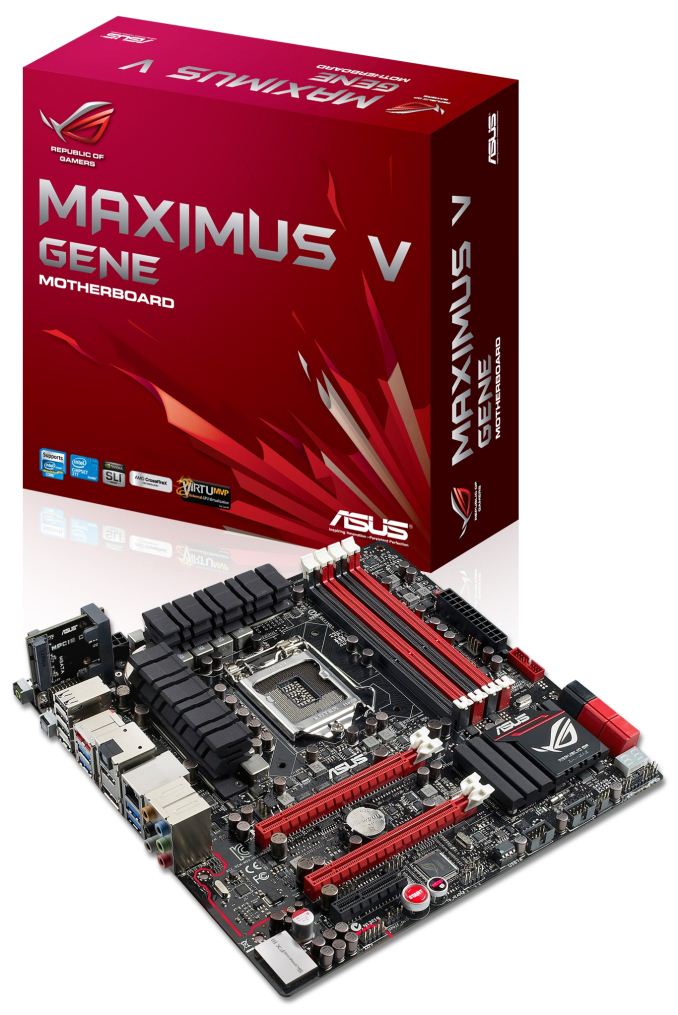
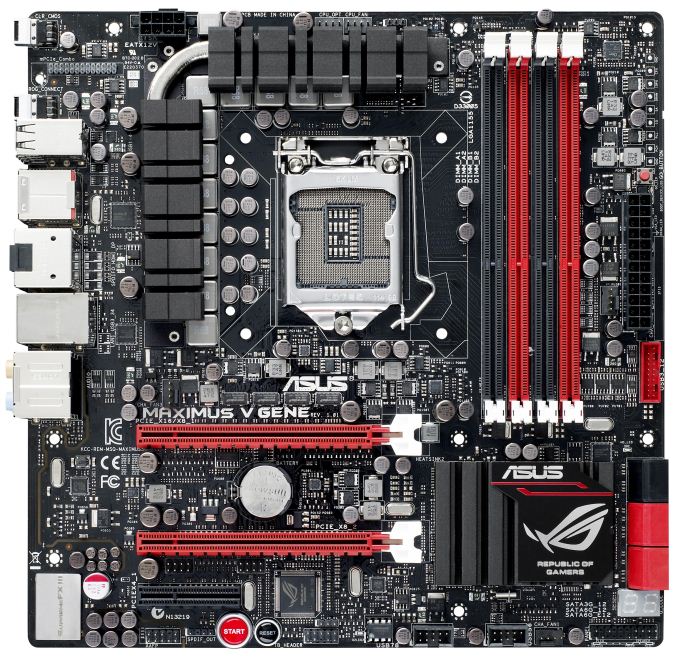
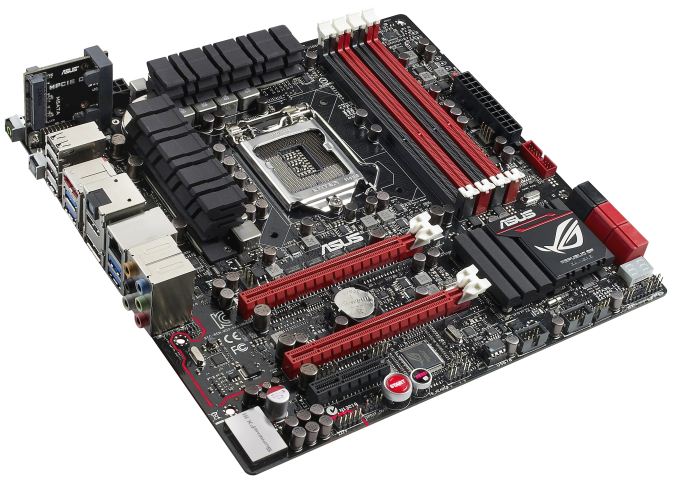
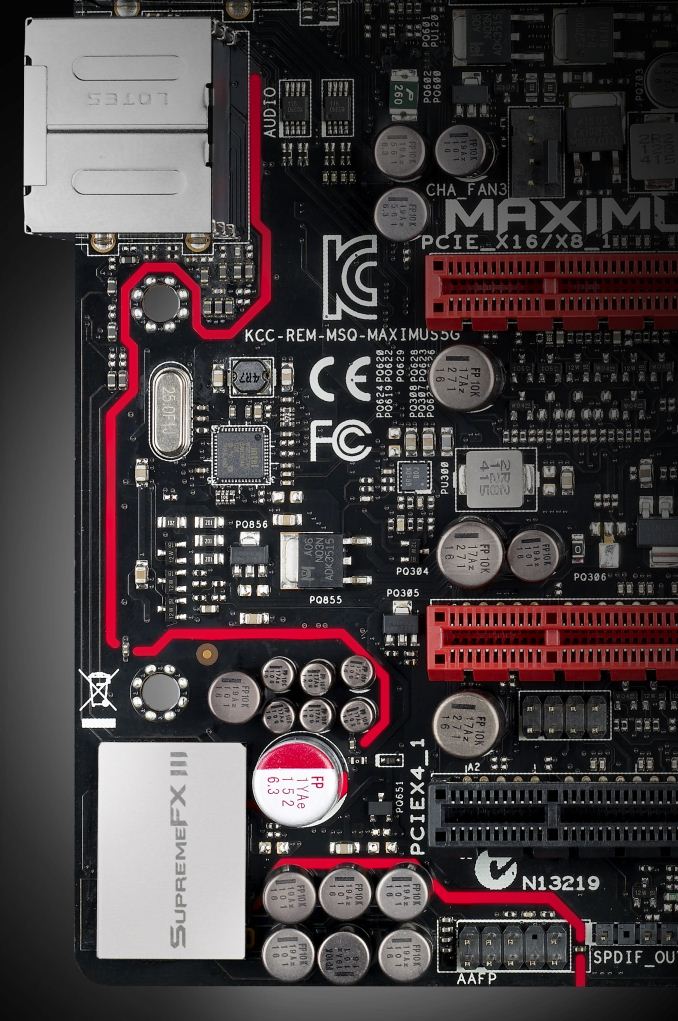
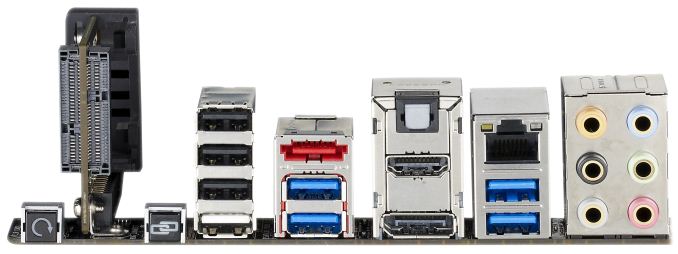














31 Comments
View All Comments
cmdrdredd - Monday, May 13, 2013 - link
For overclocking and enthusiast oriented boards you get what you pay for. This review wasn't supposed to be catered to budget builders at all.takeship - Monday, May 13, 2013 - link
I built with first the Asus Gene V, and then the M3 Sniper, all in the last 9 months. Biggest difference: the pci & fan header layout on the Gigabyte made more sense, vs transiting nearly the length of the board with the 3rd Asus fan header. Makes a mess of routing. Headers all along the edges, and the lower (none-blocking) location of the second x8 pcie were a big plus. Not to mention the larger CPU socket area. I seem to recall the Gigabyte had a better fan control setup as well, though I could be wrong (and anyways the 3D UEFI is not good). Top it off with the fact that the Gigabyte was on sale for $140 when I picked it up, far below the $205 I paid for the Asus. I love my Asus board, but I would recommend the Gigabyte over it in an instant.Samus - Monday, May 13, 2013 - link
Yikes, lost me at Creative Labs...chedrz - Monday, May 13, 2013 - link
I love my Sniper M3. It's rock-solid, stable, hasn't given me any sort of problem. I guess that makes it the exact opposite of every ASUS board I've ever owned. I was a little worried about the Creative sound also, but I fortunately have a Xonar D2X that I've been using. This board's a champ.jrs77 - Tuesday, May 14, 2013 - link
I'd wish that GA or ASUS release some high-end, but stripped motherboards where there's only the absolute minimum of components on them.Take sound for example. An $30 USB-DAC will beat any onboard-sound solution easily, and noone really needs anything else then the PEG-slots either.
The mass of USB- and SATA-ports is a waste of efforts aswell, as you usually have a single SSD + HDD, mouse, keyboard, USB-DAC and the front-USB ports for your camera etc.
Less is more, and less components result in less errors. Additionally, less components result in less board-temperature and cleaner routing.
Will never happen unfortunately :/
Rick83 - Tuesday, May 14, 2013 - link
The X58-OC did happen. It was apparently a complete failure, judging by how often in featured in giveaways.It may have been pared back a bit too much though, with only two USB ports on the back, IIRC. Of course, you can use an external hub for mice and keyboards, so that won't matter.
But given how it went the first time around, I doubt that anyone else is going to try that any time soon again.
Also, I think you're oversimplifying. PCI cards still exist, and plenty of people have one that they'd rather use in their new machine. Network cards, sound cards, that kind of thing. Why buy new, when you have a card that works perfectly well?
Also, I am currently using every one of the MIVG's rear USB outputs, AND two USB hubs.
Charging mini and micro USB, managing screens, two keyboards, a mouse, an IR receiver, a Joystick, a floppy drive, a camera - I don't think paring back on USB is an option, as I don't even have a printer, scanner, modem or DAC/ADC attached. I'm also using 4 SATA ports, for two SSDs, a hotswap bay and an optical drive. Going down to two is very limiting, given how many disks are supported by almost all cases.
Considering that you want to market to the masses in order to recoup your investment, as a mainboard maker, I doubt anyone is going to cut features (even features that are there anyway, due to the platform) only to make an expensive board, with no option for expansion.
And as for onboard sound: It's plenty good to attach a microphone, and the optical outs are also usually just dandy. Saves a USB port for other devices than a USB-DAC.
JDG1980 - Tuesday, May 14, 2013 - link
Check out the Asus P8B-X.Rick83 - Tuesday, May 14, 2013 - link
I still don't get, why GigaByte perpetually insists on adding VGA D-Sub headers to the I/O-Panel. That interface is so obsolete, it's a complete joke, and cutting back on USB 2 headers is the result. DP and HDMI are nice to have, there's a case for DVI, in case you want to dual-screen, but VGA is just not used anymore. Even budget TFTs should be coming with only digital inputs by now.It's interesting to see, that the Creative solution is clearly targeted at 48kHz usage, with results getting worse, at higher sampling rates.
When the M3 first was announced, I was excited, because finally there was a rival to the Gene series. But this first iteration is (spec-wise and price-wise) simply not in the same league.
The placement of the second x8 PCIe is the only thing that's good about it, as you probably won't run two big GPUs in a micro-ATX case, hence by putting it down there, the option remains for big cases, and in small cases there's more PCIe bandwidth available.
The downside is, that you cannot install a big card in the second PCIe, if a combination of large coolers blocks the first PCIe slot.
Ilias78 - Tuesday, May 14, 2013 - link
Always the same story with Ian: Loves Asus motherboards, while dissing every other brand...just4U - Tuesday, May 14, 2013 - link
Currently the M3 is my board of choice. I pick it over the Asus variant every time (if in stock) It's $50 cheaper than the Maximus V Gene (here in Calgary) and I like the fact that they didn't cheap out on the sound option yet still include the Intel Nic. It hits in all the right areas.